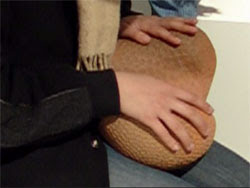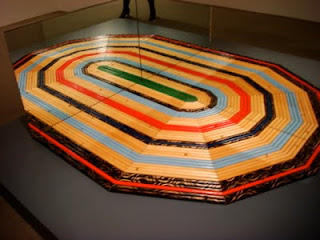 Quilt exhibitions always include "Don't Touch!" signs (now often reworded along the lines of "respect the work"). But of all things, quilts invite touch - people have a hard time keeping their hands off them - the urge is to scrunch the delectable item, to feel its reality - or just to stroke the fabric.
Quilt exhibitions always include "Don't Touch!" signs (now often reworded along the lines of "respect the work"). But of all things, quilts invite touch - people have a hard time keeping their hands off them - the urge is to scrunch the delectable item, to feel its reality - or just to stroke the fabric.Pottery has a similar draw - we like to hold mugs and cups not simply to lift drink to our mouths but to enjoy the feel of their surfaces.
 And there are people who love to sit with a pillow (or a cat) on their lap. It has been argued that our western culture is "touch hungry". In 2000 Tiffany Field published a book simply entitled Touch, which argues that many of us, children and adults alike, are deprived of touch experiences.
And there are people who love to sit with a pillow (or a cat) on their lap. It has been argued that our western culture is "touch hungry". In 2000 Tiffany Field published a book simply entitled Touch, which argues that many of us, children and adults alike, are deprived of touch experiences.Writing about her PhD research in regard to tactile ceramics, Bonnie Kemske has said, "It is easy to see how the development of our touch hungry culture has been, and is, perpetuated by one strand of Northern European/American Christian heritage that equates sensuality with sin, a determined preoccupation with intellectual achievement among our middle-class oligarchy, and a rise of affluence that has led to the purchase of more and more ‘precious’ goods that must be protected in use, or not used at all. ...Work that is touched and handled, especially on a daily basis, has ... a lower status than that which is kept safely put away in a cupboard or a display case." (Read the rest of her article here.)
Privileging the intellect and excluding sensation is being challenged, and part of this is the move to introduce more and more children to craft, eg through Craft Club. (Another strand is the way phenomenology challenges the Cartesian mind/body duality, but we won't grapple with that here.)
"Look but don't touch" has long been the watchword in galleries and museums. But art has crossed the visual barrier to engage with other senses, as you'll know if you've visited one of Anya Gallacio's installations of rotting flowers.
 Video and sound too have crossed the visual barrier into the world of art, and the terms "sense memory" and "imagined touch" are being used.
Video and sound too have crossed the visual barrier into the world of art, and the terms "sense memory" and "imagined touch" are being used.As inhabitants of a touch-hungry culture we want tactile experiences ... so some of us work with fabric or with clay, or paint we make the objects that, on a wall or on a plinth, would be forbidden for all but the owners to touch.
So let me end with the hope that the sense of touch will be more appreciated, and that art will touch people in more than a visual way. And that touching won't be such a no-no -- for example, in quilt exhibitions by providing "touching samples" near the work. I believe that the physical connection is so very important - to be able to pick something up and hold it in your hands, or run your hands over the surface.















































